Abstract
The virulence mechanisms of Vibrio vulnificus biotype 2 have been studied and compared with those of biotype 1 in mice as the experimental animals. Biotype 2 isolates from European eels were as virulent for mice as biotype 1 strains (50% lethal dose, about 10(5) CFU per mouse); a septicemic infection developed in less than 24 h. These strains had several properties in common with biotype 1 organisms including capsule expression, uptake of various iron sources, and production of exoproteins, whose role in mouse virulence has been demonstrated. We also discuss the implication of biotype 2 strains in human infections.
Full text
PDF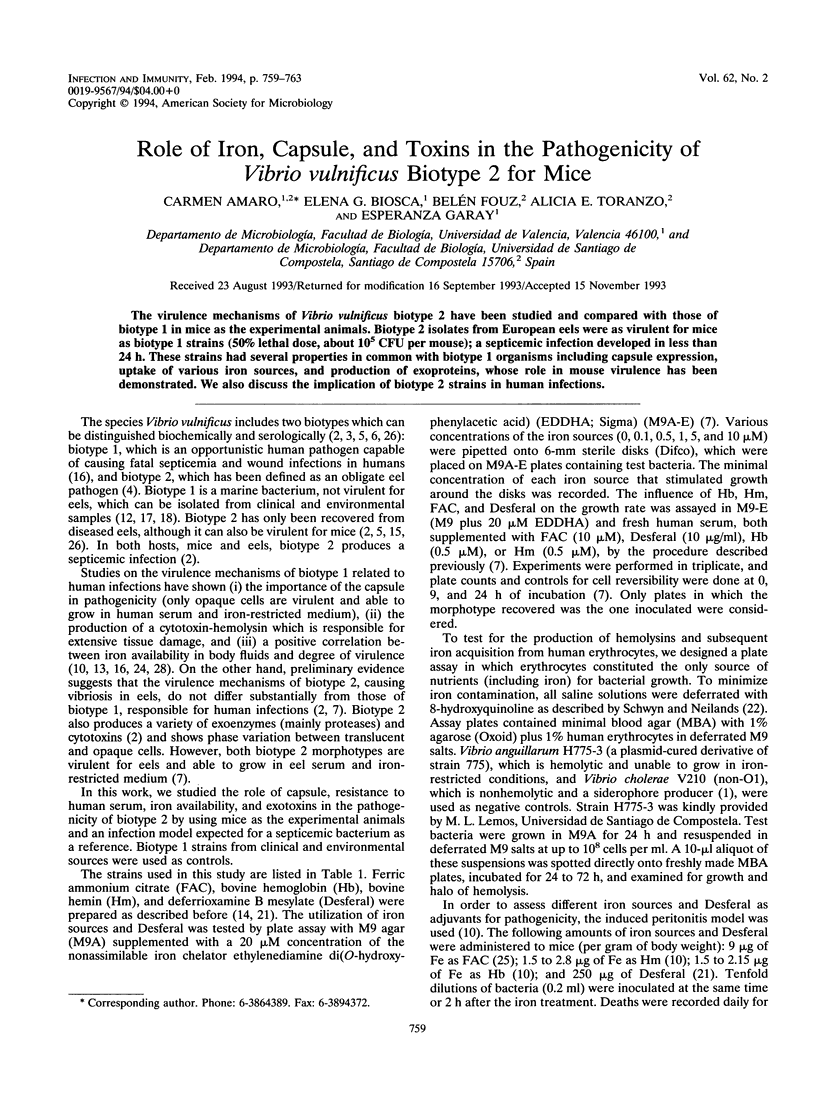
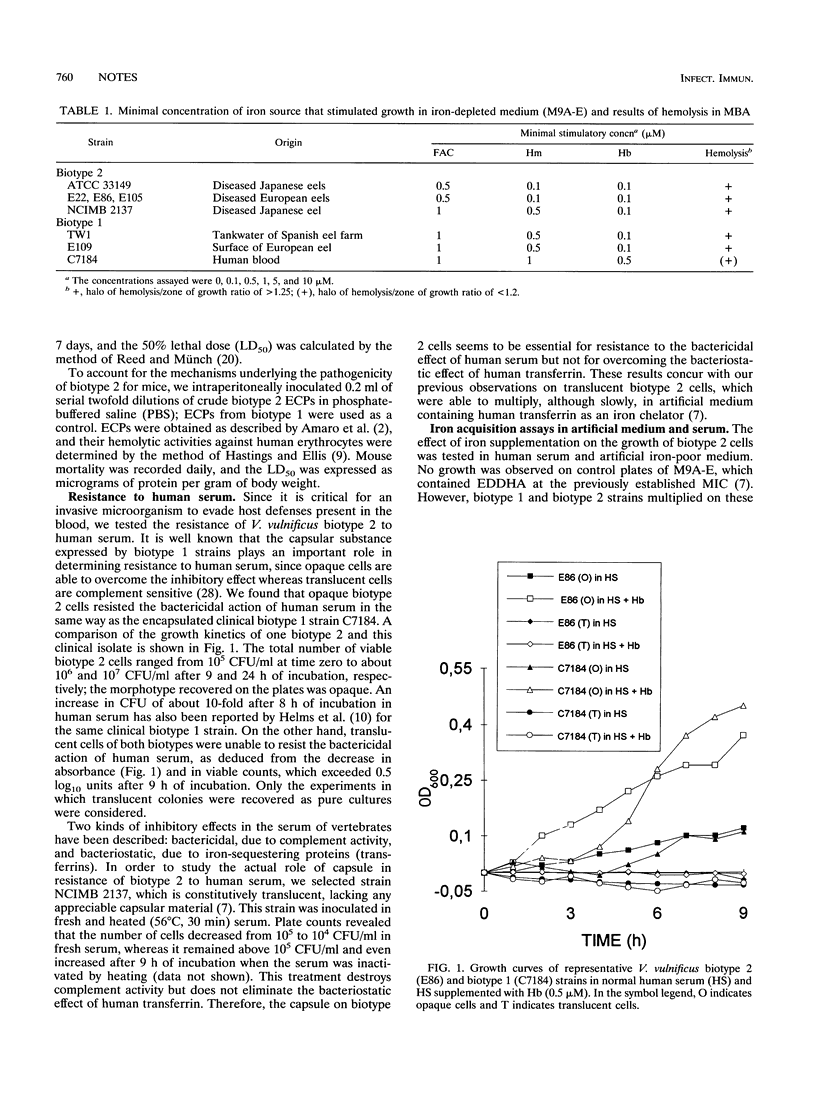
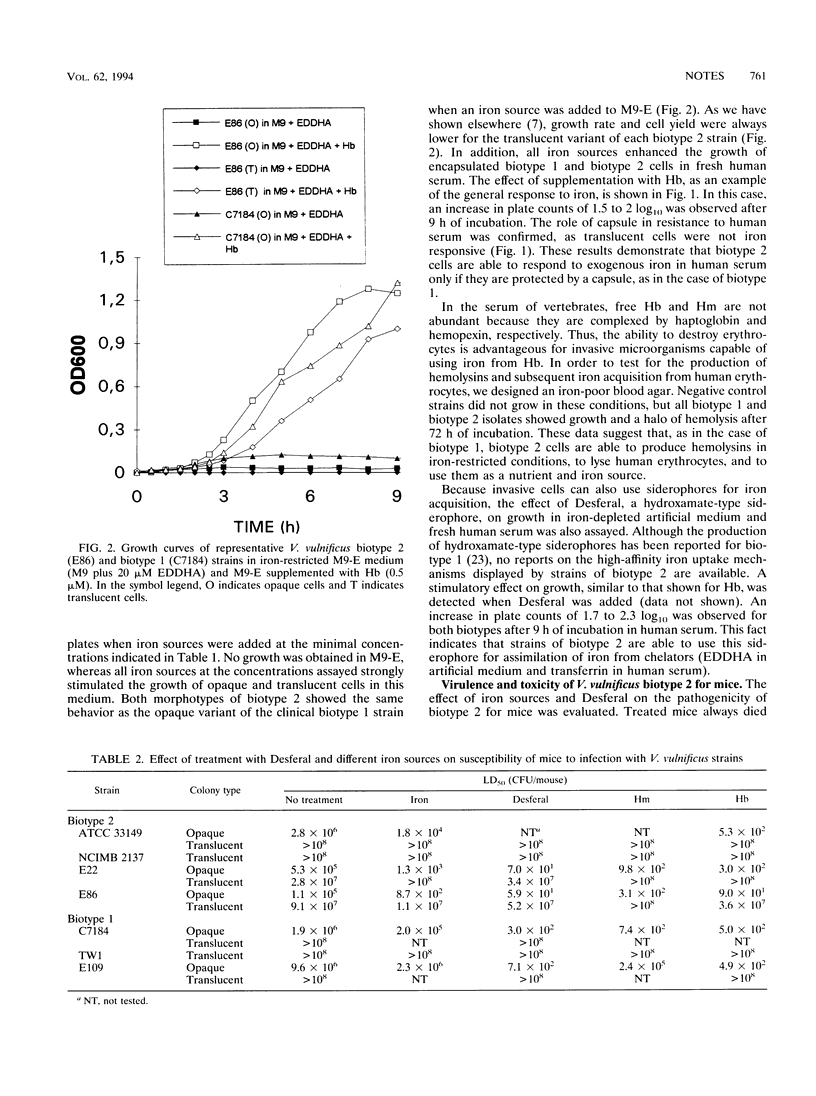
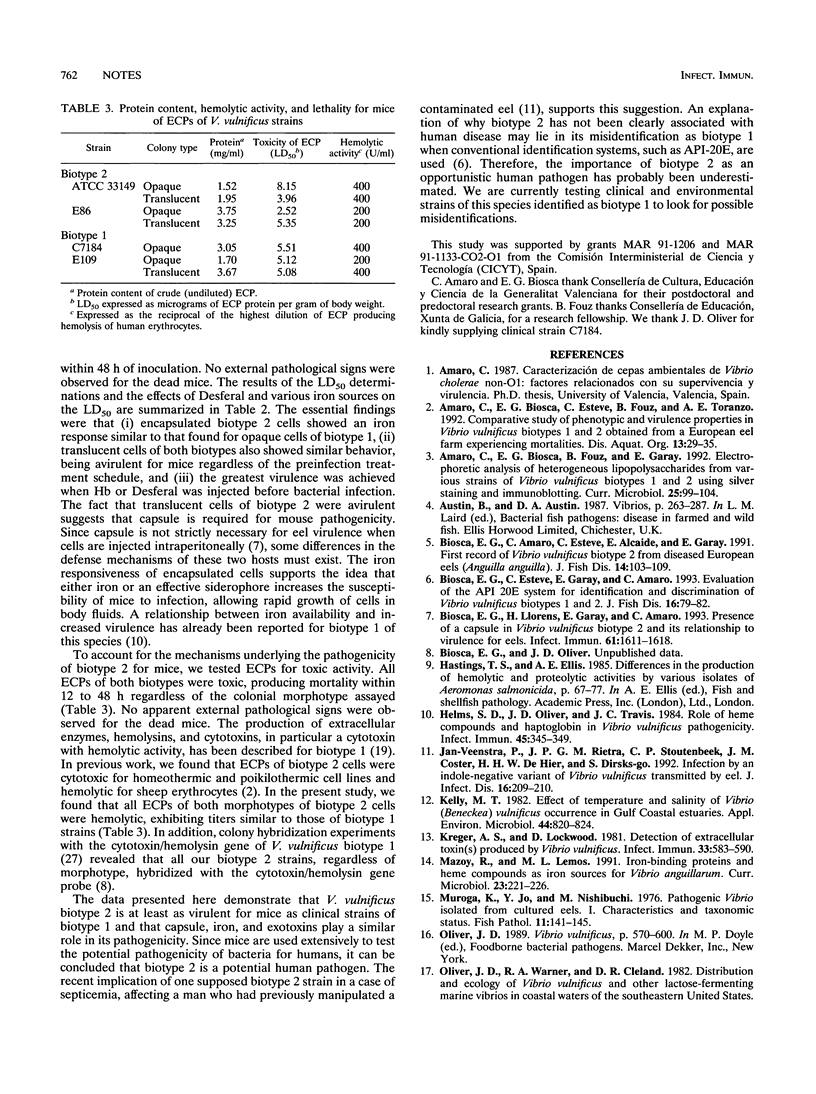
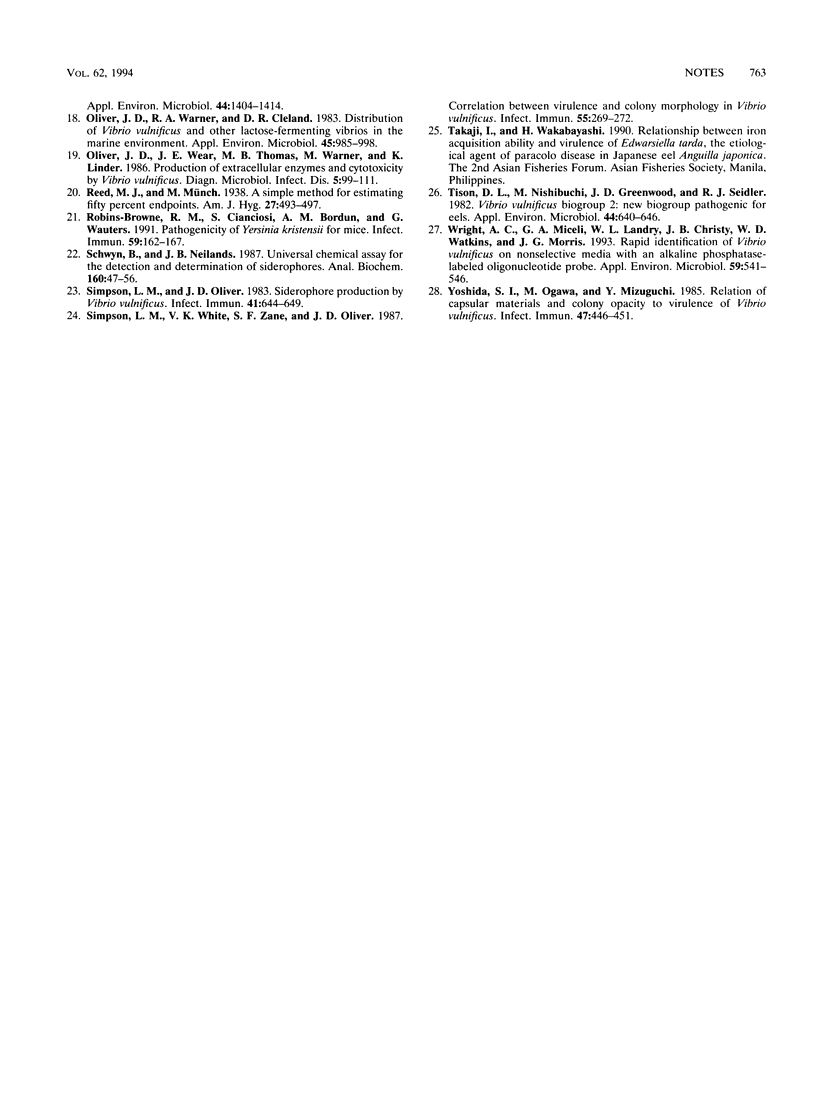
Selected References
These references are in PubMed. This may not be the complete list of references from this article.
- Amaro C., Biosca E. G., Fouz B., Garay E. Electrophoretic analysis of heterogeneous lipopolysaccharides from various strains of Vibrio vulnificus biotypes 1 and 2 by silver staining and immunoblotting. Curr Microbiol. 1992 Aug;25(2):99–104. doi: 10.1007/BF01570967. [DOI] [PubMed] [Google Scholar]
- Biosca E. G., Llorens H., Garay E., Amaro C. Presence of a capsule in Vibrio vulnificus biotype 2 and its relationship to virulence for eels. Infect Immun. 1993 May;61(5):1611–1618. doi: 10.1128/iai.61.5.1611-1618.1993. [DOI] [PMC free article] [PubMed] [Google Scholar]
- Helms S. D., Oliver J. D., Travis J. C. Role of heme compounds and haptoglobin in Vibrio vulnificus pathogenicity. Infect Immun. 1984 Aug;45(2):345–349. doi: 10.1128/iai.45.2.345-349.1984. [DOI] [PMC free article] [PubMed] [Google Scholar]
- Kelly M. T. Effect of temperature and salinity on Vibrio (Beneckea) vulnificus occurrence in a Gulf Coast environment. Appl Environ Microbiol. 1982 Oct;44(4):820–824. doi: 10.1128/aem.44.4.820-824.1982. [DOI] [PMC free article] [PubMed] [Google Scholar]
- Kreger A., Lockwood D. Detection of extracellular toxin(s) produced by Vibrio vulnificus. Infect Immun. 1981 Aug;33(2):583–590. doi: 10.1128/iai.33.2.583-590.1981. [DOI] [PMC free article] [PubMed] [Google Scholar]
- Oliver J. D., Warner R. A., Cleland D. R. Distribution of Vibrio vulnificus and other lactose-fermenting vibrios in the marine environment. Appl Environ Microbiol. 1983 Mar;45(3):985–998. doi: 10.1128/aem.45.3.985-998.1983. [DOI] [PMC free article] [PubMed] [Google Scholar]
- Oliver J. D., Wear J. E., Thomas M. B., Warner M., Linder K. Production of extracellular enzymes and cytotoxicity by Vibrio vulnificus. Diagn Microbiol Infect Dis. 1986 Jul;5(2):99–111. doi: 10.1016/0732-8893(86)90112-4. [DOI] [PubMed] [Google Scholar]
- Robins-Browne R. M., Cianciosi S., Bordun A. M., Wauters G. Pathogenicity of Yersinia kristensenii for mice. Infect Immun. 1991 Jan;59(1):162–167. doi: 10.1128/iai.59.1.162-167.1991. [DOI] [PMC free article] [PubMed] [Google Scholar]
- Schwyn B., Neilands J. B. Universal chemical assay for the detection and determination of siderophores. Anal Biochem. 1987 Jan;160(1):47–56. doi: 10.1016/0003-2697(87)90612-9. [DOI] [PubMed] [Google Scholar]
- Simpson L. M., Oliver J. D. Siderophore production by Vibrio vulnificus. Infect Immun. 1983 Aug;41(2):644–649. doi: 10.1128/iai.41.2.644-649.1983. [DOI] [PMC free article] [PubMed] [Google Scholar]
- Simpson L. M., White V. K., Zane S. F., Oliver J. D. Correlation between virulence and colony morphology in Vibrio vulnificus. Infect Immun. 1987 Jan;55(1):269–272. doi: 10.1128/iai.55.1.269-272.1987. [DOI] [PMC free article] [PubMed] [Google Scholar]
- Tison D. L., Nishibuchi M., Greenwood J. D., Seidler R. J. Vibrio vulnificus biogroup 2: new biogroup pathogenic for eels. Appl Environ Microbiol. 1982 Sep;44(3):640–646. doi: 10.1128/aem.44.3.640-646.1982. [DOI] [PMC free article] [PubMed] [Google Scholar]
- Veenstra J., Rietra P. J., Stoutenbeek C. P., Coster J. M., de Gier H. H., Dirks-Go S. Infection by an indole-negative variant of Vibrio vulnificus transmitted by eels. J Infect Dis. 1992 Jul;166(1):209–210. doi: 10.1093/infdis/166.1.209. [DOI] [PubMed] [Google Scholar]
- Wright A. C., Miceli G. A., Landry W. L., Christy J. B., Watkins W. D., Morris J. G., Jr Rapid identification of Vibrio vulnificus on nonselective media with an alkaline phosphatase-labeled oligonucleotide probe. Appl Environ Microbiol. 1993 Feb;59(2):541–546. doi: 10.1128/aem.59.2.541-546.1993. [DOI] [PMC free article] [PubMed] [Google Scholar]
- Yoshida S., Ogawa M., Mizuguchi Y. Relation of capsular materials and colony opacity to virulence of Vibrio vulnificus. Infect Immun. 1985 Feb;47(2):446–451. doi: 10.1128/iai.47.2.446-451.1985. [DOI] [PMC free article] [PubMed] [Google Scholar]


